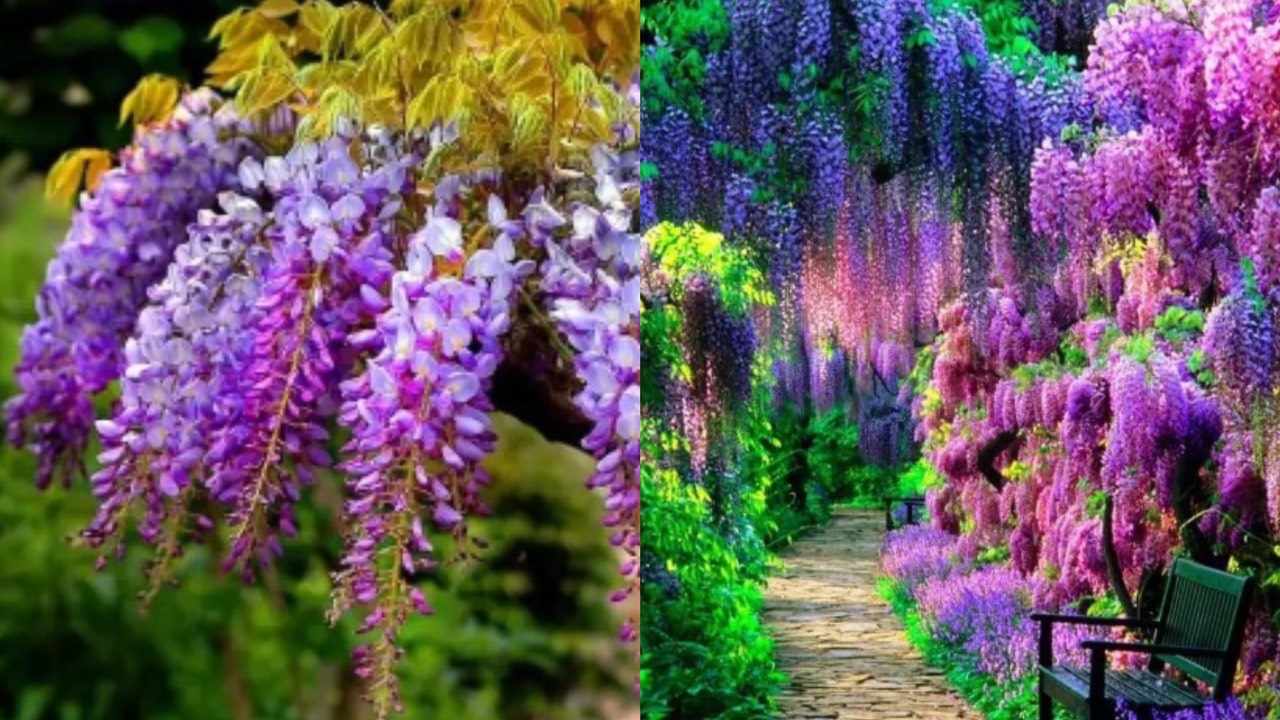
It fills the space with a firework of various colors and shades – from light blue, and pale pink, to intense purple and creamy white, in which the inflorescences are painted in the form of long spectacular brushes, an abundant waterfall hanging down. When the wisteria blossoms, a walk among this paradise whirlpool of colors resembles a magical dream, where there is no place, no sadness, no sorrow. After all, it is not for nothing that they say that being in her environment, you seem to be in a real paradise.
Translated from Greek, the name of this plant denotes the epithet “sweet.” It really throughout the flowering stage fills the surrounding atmosphere with a pleasantly sweet aroma. This is one of the most beautiful flowering representatives of the flora.
Wisteria refers to deciduous woody forms. Its height can reach twenty meters. As the tree grows, a magnificent crown is formed with a diameter of up to eight meters from drooping long branches.

The adult wisteria tree has different shapes. It can be a tree with a powerful trunk or a weaving creeper, gradually capturing the surrounding space of your garden.
The unpaired light-green leaves of wisteria are large, reaching a length of 30 cm. The fluff covering the leaf plates of young plants gradually disappears, making their color more saturated.
Blue, violet, white, pink, lilac flowers of wisteria are combined in racemes, resembling grape clusters, the length of which varies on average from 25 to 50 cm. Although, there are varieties of wisteria with inflorescences up to 70 cm long.
Wisteria is a natural habitat for China, where it grows in the provinces of Sichuan and Hubei. This tree is widely cultivated but shows the greatest decorativeness in humid subtropics.
Starting to bloom in the first spring months, the wisteria tree charms with a cloud of multicolor almost until the beginning of autumn, after which the ripening beans are used as seed.

Wisteria – growing, and reproduction
There are many ways to independently grow wisteria in a summer cottage. The most practical and effective methods of which are:
Seed
Vegetative
Seed breeding
Seed cultivation of wisteria – is rarely used, since the young seedling practically does not acquire the varietal characteristics of the mother plant.
Sowing material is purchased in specialized salons or collected independently if there are adult plants on the site.
Soil preparation
At the beginning of winter, a soil substrate is prepared by mixing in equal volumes of turf soil, leaf humus, and fine sand. You can buy a ready-made mixture, oriented to exotic representatives of the flora. The resulting soil is poured into containers.
Sowing events are carried out in several stages:
Seeds are preliminarily poured with a solution of a growth stimulator, diluted according to the instructions and they are kept there for about three hours.
They are laid out on a moistened surface of the soil.
A thin layer of sand is distributed on top, which should slightly cover the seeds. Then cover with a transparent film and place a miniature greenhouse in a warm place without lighting with a temperature of at least twenty degrees.
Next, daily airing is carried out and, if necessary, the soil is sprayed with water, preventing it from drying out. The shelter is removed on average after a month when the active sowing of seeds begins.
Two weeks later, move the container to the windowsill, providing protection from the midday hot sun. Sprouts at this moment are regularly irrigated with a spray gun, but I avoid strong waterlogging, which can cause rot of young stems.
When the third leaf develops, the shoots are ready for transplanting into local containers, in which they arrange a drainage layer at the bottom and pour in soil substrate. In the container, the soil is watered and seedlings are carefully removed, keeping a lump of earth. Immediately planted in prepared containers, after which the transplanted plants are watered with a weak solution of potassium permanganate.

Vegetative propagation methods
The vegetative method of growing wisteria has also worked well. For the reproduction of plants, it is most often used:
Cuttings
Propagation by layering
Root vaccination
Graftage
The simplest, but no less effective way to grow wisteria is the method of grafting. It is performed as follows:
In autumn, choose a healthy strong branch and cut the cuttings with a length of 15 to 20 cm. For storage, they are placed in the cellar, sprinkled with moist soil.
In the spring, for rooting growth, cuttings are planted in a greenhouse under the film, previously having kept them in the stimulator.
In warm weather, cuttings can be placed directly in the open ground. For this, the selected site with light fertile soil is well dug up, weed roots are removed from it. Next, the surface is leveled with a rake and the prepared cuttings are buried into it a few centimeters. Each copy is covered with glass jars on top. You can use plastic bottles with cut off necks for this purpose.
Chinese carnation ‘The Dancing Geisha’ an exotic plant for your garden

In late autumn, wisteria is prepared for wintering. For this, the near-stem circle is loosened and the plant is highly spud. Mulch is placed on top. Shoots are removed from the supports. They carefully wrap the trunk, cover with leaves. Covering non-woven material is placed on top.
Pests on wisteria rarely occur, but damage to aphid leaves, caterpillars, ticks, and even ants can sometimes be observed. Processing is carried out with biological preparations or insecticidal preparations, which are diluted in accordance with the instructions.














